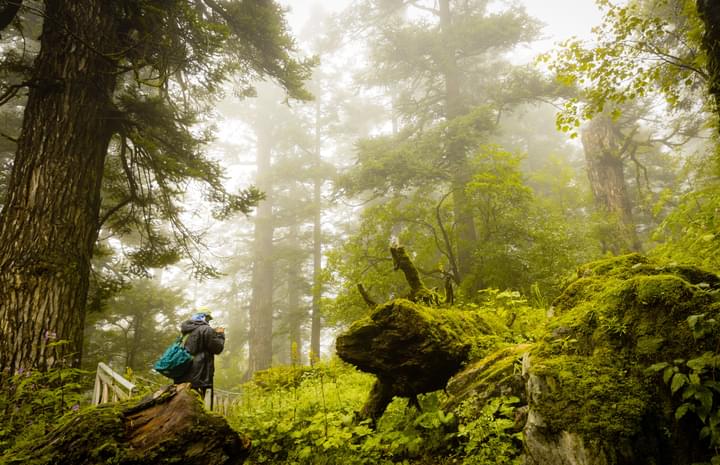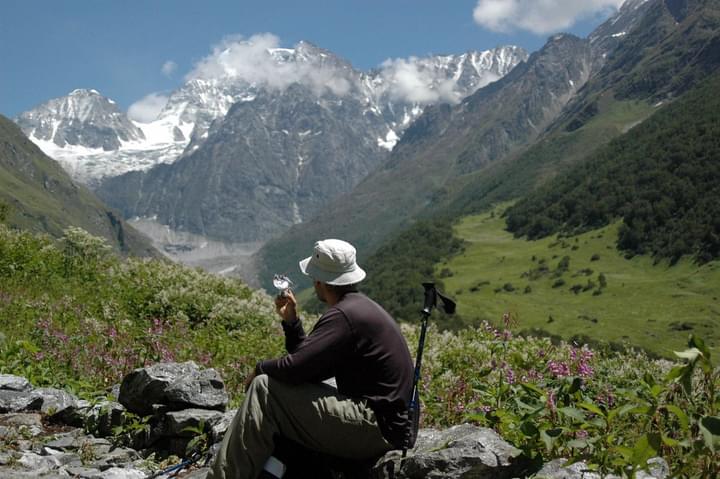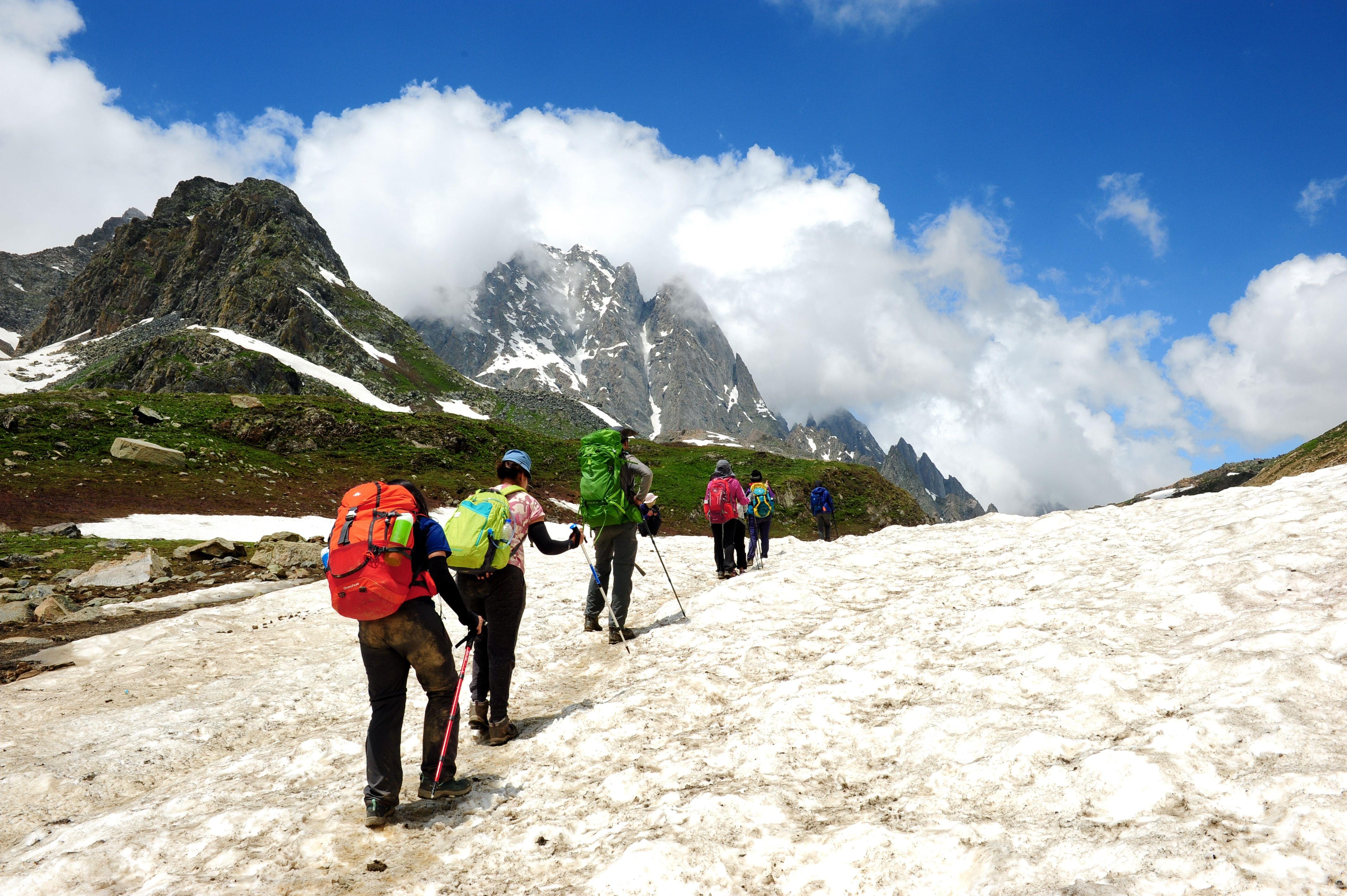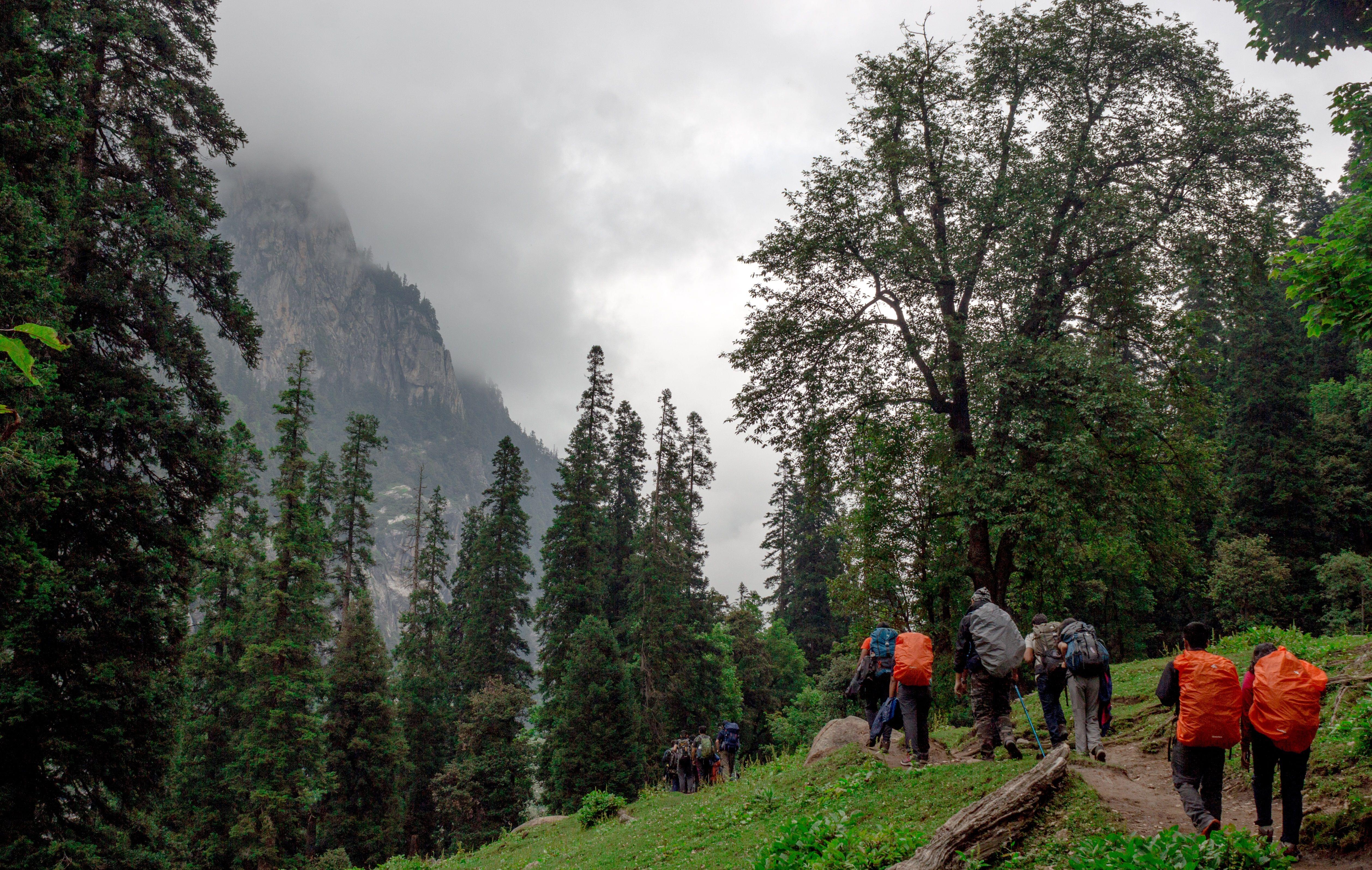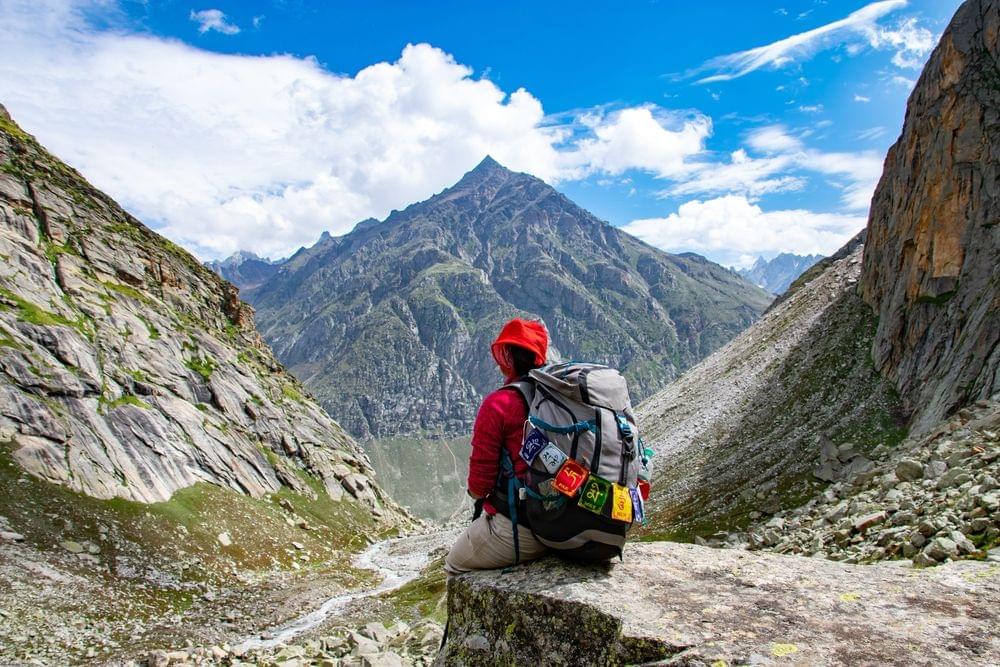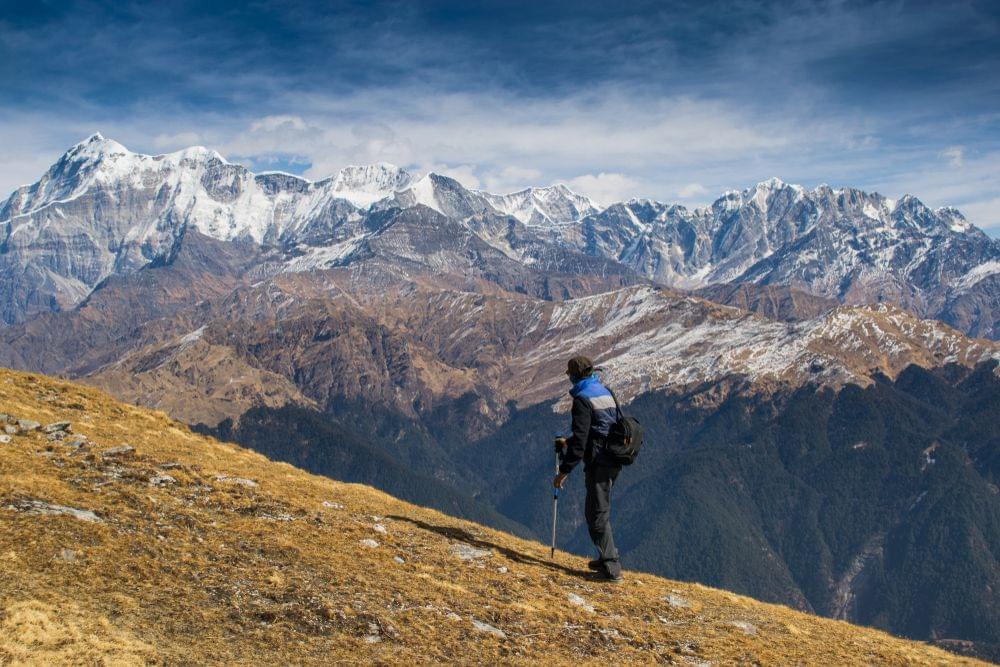Valley of Flowers Trek Overview
Quick Facts of Valley of Flowers Trek
- Maximum altitude – 14,107 feet
- Grade – Easy to Moderate
- Duration – 6 days & 5 nights
- Trekking distance – 38 kilometres
- Trail Type – Walking trail with well-defined pathways and steep ascents and descents at some points.
- Rail Head – Rishikesh Railway Station, Uttarakhand.
- Airport – Jolly Grant Airport of Dehradun, Uttarakhand. An alternate method is landing at Delhi’s IGI Airport and taking a bus or train to Haridwar.
- Base Camp – Govindghat
- Best Season – From July to September
- Region – Located in Chamoli district of Uttarakhand in the Himalayan Mountain ranges.
- Who can participate – Anyone with good fitness levels.
Short Itinerary for Valley of Flowers Trek
Valley of Flowers Trek Detailed Itinerary
Reaching the base camp at Govindghat
Distance: 300 kilometres
Duration: 10 hours
Elevation: 6,215 feet
- Assemble at the pre-decided location in Haridwar as per your Valley of Flowers trek package, from where your guide will provide a short overview of the journey ahead.
- Embark on a 10-hour drive up to Govindghat from Haridwar. Food will be available aplenty on this route so no need to carry some.
- Drive along the stunning Alaknanda River and also experience the beauty of Devprayag, where the Bhagirathi and Alaknanda rivers meet to form the holy River Ganges.
- Pass through Joshimath, which is one of the most popular destinations en route to religious pilgrimages.
- Stay at Govindghat for the night. Govindghat is the final point where mobile networks are available before the trek, hence make all the calls you need to before starting your journey.
Govindghat to Ghangharia via Poolna
Distance: 13 kilometres
Duration: Approx 6 hours
Elevation: 10,250 feet
- The 13-kilometre distance between Govindghat and Ghangaria now has an alternating setup of driving and trekking.
- Rides from Govindghat take you four kilometres to Poolna, from where the trekking begins.
- The nine-kilometre trek from Poolna to Ghangaria takes approximately five to six hours on the well-defined trail that runs along the river.
- The trail can be sunny or shaded at different intervals, and has ample eating spaces for trekkers. Ghangaria village has hotels, restaurants, gurudwara, helipad, and some camping space for trekkers.
- The altitude gained on this easy-moderate trail of gradual descent is from 6,215 feet to 10,250 feet, via 6,720 feet.
- Stay at Ghangharia for the night.
Ghangharia – Valley of Flowers – Ghangharia
Distance: 3.7 kilometres (one side)
Duration: Approx 7 hours
Elevation: 11,550 feet
- The trek ahead from Ghangaria to the Valley of Flowers is a mere 3.7 kilometres and is an easy, flat walk in the valley.
- Leave Ghangaria in the early morning so you could spend the day at the Valley of Flowers.
- Less than a kilometre into the trek, the trail splits and takes you to the gate where you can buy your entry tickets.
- As you reach an altitude of 11,550 feet from 10,520 feet, you get to witness the legendary beauty of the iconic Valley of Flowers.
- The valley stretches for approximately 5-7 kilometres, after exploring which you would need to head back to Ghangaria for staying the night.
Ghangharia – Hemkund Sahib Gurudwara - Ghangaria
Distance 6 kilometres (one side)
Duration: 10 hours
Elevation: 14,107 feet
An early start to the day is absolutely essential, as you would have to cover 6 kilometres each way between Ghangaria and Hemkund Sahib.
Trekkers reach an altitude of 14,107 feet from 10,520 feet and come back down over a period of approximately 10 hours.
This moderate-difficult trek, which includes a steep ascent of around 4 hours to Hemkund Sahib and steep descent back, is popular as a serenely beautiful pilgrimage trek.
A highlight of the trek is the Hemkund Sahib Lake, a calm attraction in the midst of tall mountains. This trail is the most strenuous part of the Valley of Flowers trek.
By afternoon, begin the steep descent back to Ghangharia, where you would stay overnight.
Ghangharia to Govindghat via Poolna
Distance: 13 kilometres
Duration: Approx 5 hours
Elevation: 6,215 feet
- The trail back to the real world is an easy-moderate trek and drive covering 13 kilometres and a drop in altitude from 10,520 feet to 6,215 feet.
- The gradual descent from Ghangaria to Poolna covers a distance of nine kilometres along the river, which can be embarked upon after a good rest at Ghangaria, much needed after the Hemkund Sahib trek.
- The well-defined trail has numerous eateries and takes you to Poolna in around 5 hours.
- Take a ride from Poolna to cover the remaining four kilometres and reach the Valley of Flowers trek base camp at Govindghat, where you rest for the night.
Govindghat to Haridwar
Distance: 300 kilometres
Duration: 10 hours
Elevation: 1,030 feet
- The Valley of Flowers trek package is primarily a monsoon trek, which in the mountains of Uttarakhand is a season marked by landslides. It is highly recommended that you keep this detail in mind when you plan your trek and keep a buffer day for the same.
- The drive from Govindghat to Haridwar takes approximately ten hours, with the sites being located at a distance of around 300 kilometres. Soak in the enchanting views of the Alaknanda River on your way.
- Pass through Joshimath and Devprayag en route. Relish some local delicacies on the way as you stop at the various eateries on the way to Haridwar.
- Reach Haridwar by evening, and either stay the night or catch transportation to reach back home.
General Trivia About Valley of Flowers Trek
Valley of Flowers is among the most popular attractions of Uttarakhand and is the epitome of Himalayan exquisiteness. From lush greenery to vibrant blooms, experience nature at its finest as you trek through the valley and witness snow-clad peaks, tall mountains, and flowing rivers amidst a sea of flora.
It was in 1931 that a group of British mountaineers, lost on their way to Mt Kamet, stumbled upon a valley full of alpine flowers, and named it ‘The Valley of Flowers’. Locals, however, knew of the valley as a land of the gods and fairies.
The legend also mentioned how when one went to the valley, they were captured by the fairies and never came back. By 1980, the Indian government had recognised this abode of nature as a National Park, and it was in 2002 that the site got its most prestigious tag, that of being a UNESCO World Heritage Site.
While the traditional trek route is known to be the Govindghat – Ghangaria route, there once existed another route that has recently been reopened to visitors. It was in 1970 that the alternate route, known as the Kunthkhal – Hanuman Chatti route, was closed for visitors due to the rising popularity of the Ghangaria route.
After a long period of no human contact, the Kunthkhal route is more adventurous and has stunning visual treats that can’t be found on the traditional route. So, if you are looking for a trek that indulges your explorer instincts, try out this alternate route for your Valley of Flowers trek.
Know Before You Go to Valley of Flowers Trek
Valley of Flowers trek package offers an easy to moderate trekking experience, but it's not that simple! From amateurs to senior trekkers, all those opting to embark on this trek need to remember a few important tips to ensure they make the best out of this journey to the crowning jewel of Himalayan treks.
- It is advised that you rest for at least a night at Haridwar before starting your Valley of Flowers trek. This would help you be well-rested and acclimated to the high altitude before your trek.
- Much of the essentials, like shoes, backpacks, padded jackets, and rainwear, are available for rent at the stores near the base camp, in case you miss out on carrying any of the items.
- Remember to carry the necessary medications and do not consume any general medications without consulting your trek leader. Also, trek leaders carry a plethora of life-saving drugs in case you need immediate care during the trek.
- It is always recommended that you wear a minimum of three layers of light woollens on your trek. Carrying and wearing one thick woollen is tiresome and at times inadequate, hence layers are a better solution.
- Ensure that your belongings are water-resistant or can withstand rains and snow, as the Valley of Flowers trek package offers a monsoon trek, with heavy rains lashing the valley throughout the trekking season.
- It is highly recommended that you stay hydrated at all times throughout the trek. Carry a few ORS packets and an insulated water bottle so you don’t experience dehydration during the long day hours of the Valley of Flowers trek.
There has traditionally been one route for the Valley of Flowers trek, known as the Govindghat – Ghangaria route. Recently, however, another route, which was the original route before it was closed off in 1970, has been reopened for visitors and is known as the Kunthkhal – Hanuman Chatti route.
Govindghat – Ghangaria route: This route begins from Govindghat, which is the base camp for the Valley of Flowers trek. Govindghat is accessible from Haridwar, Rishikesh and Joshimath. The next stop on the journey is Ghangaria, which one reaches via Pulna village. After Ghangaria, trek up to the iconic Valley of Flowers via the well-trodden path. Hemkund Sahib Gurudwara is the highest and final point in this route. Trace back the same trail back until you reach Govindghat.
Koonthal – Hanuman Chatti route: This alternate route is more difficult than the regular route, and is meant for adventurous trekkers wishing to explore new trails. The base camp is at Govindghat, and the route is similar to the traditional one till Ghangaria and changes thereafter. Experience the Valley of Flowers as you climb up to Kunthkhal via the newly opened route after Ghangharia. The next stop is at Palsi Uddyar, which is a small meadow. The final stop is at Hanuman Chatti, from where you can take a ride directly to Badrinath or Joshimath.
The best time to embark on the Valley of Flowers trek, which opens to visitors in June, is during the months of July, August, and September. The trek is not known for its snow experience, but trekkers might witness snow patches in the early season. The day temperatures in these months range between 10 and 18 degrees Celsius, while temperatures at night drop to a minimum of 3 degrees.
The Valley of Flowers trek package offers unique experiences in different months. In July, when the snow is still melting, trekkers can witness flowers as they begin to bloom. A vision to behold with the myriad colours of the flowers, the valley has the least number of visitors this month. As monsoon gains momentum in the second half of the month, expect lush greenery like never before as you trek through the valley.
The maximum number of flowers can be witnessed in August when monsoon rains wash the valley and bring alive a world of stunning colours. While weekends see crowds, if you plan a trek on the weekdays, you would be able to enjoy the blossoms at leisure.
With the end of August and by September, flowers have mostly wilted, but visitors are graced with views of the bewitching mountains as the monsoon ends. September sees the highest crowds in the valley as pilgrims visit the Hemkund Sahib Gurudwara.
Trekking shoes: Durable trekking shoes that withstand snow and rain as well as provide ankle support and good grip.
Backpack: Ideal capacity of 50 to 60 litres and offers proper hip and shoulder support and has quick access pockets.
Clothes: Choose synthetic dry-fit T-shirts for the base camp and a minimum of three warm layers for the trek. Include light woollens like inner thermals, fleece layers, light sweaters, and a padded jacket.
Trek Pants: Take a maximum of two pairs of quick-dry trek pants with zippered pockets for your necessary accessories.
Accessories: Some mandatory accessories include sunglasses, sun caps, hand gloves, woollen caps, socks, headlamps, a pair of trekking poles, rainwear, a rain cover for your backpack, and an optional daypack of 20-30 litres.
Kits: Take along a toilet kit that includes basics like toothbrush and toothpaste, small soap and toilet paper, small moisturiser, roll-on deodorant, lip balm, and sanitary napkins. Cutlery like a lunchbox, mug, spoon, and plastic bags to keep your used clothes come in handy too.
Medical kit
It is advised that you carry a medical kit with all necessary supplies with you at all times. Important recommended medications include Diamox for ACM, Dolo 650 for fevers, Avomine for motion sickness, Combiflam for muscle aches, Digene for indigestion, and ORS for replenishment. Remember to carry simple first aid items and your specific medications in your kit.
- Documents
Carrying an original government-approved ID card and its photocopy, a passport-size photograph, a disclaimer certificate, and a medical certificate from a practising doctor are necessary for the Valley of Flowers trek package. It is advised that you take them along in a plastic folder in your trekking backpack.
The starting point for the Valley of Flowers trek package is at Haridwar, Uttarakhand. One can reach this stunning town either by air from Dehradun or by train and bus from Delhi, which are the nearest centres that offer direct connectivity to Haridwar.
By Air: If you wish to take a flight, Dehradun’s Jolly Grant Airport, located around 28 kilometres away from Haridwar, is the nearest. Take a taxi, auto, or bus to reach Haridwar from the airport. One can also opt to fly to Delhi and take a train or bus to reach Haridwar.
By Train: Haridwar has its own railway station which is well-connected to the rest of India. One can get direct trains to Haridwar from major cities like Delhi, Kolkata, Mumbai, Ahmedabad, Jaipur, Bhubaneswar, Patna, Kochi, Varanasi, Gaya, Puri, and Deharadun.
By Bus: One can find comfortable buses from Delhi’s ISBT Kashmere Gate for Haridwar. The journey takes approximately five hours.
Once you reach Haridwar, it is highly recommended that you spend a night here to ensure you are well-rested and acclimated to the environment before you embark on your Valley of Flowers trekking package.
One needs to hop on a bus from Haridwar to reach Govindghat, which is the base camp of the Valley of Flowers trek. Another drive from Govindghat to Poolna takes you to the starting point of your much-anticipated Himalayan trek.
Why to Go for Valley of Flowers Trek?
FAQ's of Valley of Flowers Trek
How Difficult is the trek to Valley of Flowers?
The difficulty level of a trek is determined based on many factors, which range from weather conditions and the nature of the terrain to the distance covered each day and the highest altitude. The Valley of Flowers trek, which at its highest altitude elevates 14,107 feet, has been rated as an easy to moderate level trek. Well paved and defined, the trek has several easy exits, with ponies available for hire if you wish to reduce the difficulty level of the trek.
Recommended for beginners and experienced trekkers alike, those choosing the Valley of Flowers trekking package need to have good fitness levels. If you plan to trek through the enchanting valley and want to know if you meet the required fitness levels, a simple test is running for five kilometres in less than forty minutes.
Make your workout consistent by aiming to complete 20 kilometres of jogging in a week to prepare for your Himalayan trek. Fitness is an important factor as you would have to walk approximately six to eight kilometres every day, walk through tricky patches and small streams, and experience deep ascents and descents.
How long is the Valley of Flowers trek?
The Valley of Flowers trek lasts for four days, excluding the time needed to drive to and from the trek starting point. The trek duration can also be extended as per your convenience. The trek is 38 kilometres long and encompasses exquisite floral blooms, serene water streams, and stunning views of the mighty mountains.
How fit do I need to be to do the Valley of Flowers trek?
The Valley of Flowers trek has an easy-to-moderate difficulty level, but nevertheless requires trekkers to have good fitness levels. The trek has lengthy high-altitude climbs on all days of the tour, so adequate fitness is necessary to ensure trekkers can embark on the journey. You must be able to run for five kilometres in less than forty minutes. Make your workout consistent by aiming to complete 20 kilometres of jogging in a week to prepare for your Himalayan trek.
How safe is the Valley of Flowers trek?
As one of the oldest and most well-known Himalayan treks, the Valley of Flowers is absolutely safe for trekkers of all experience levels. The paths are well-defined and well-laid, although the ascent can get a bit steep at places. Many visitors trek through the valley at all times so that you won’t be alone on your journey. Remember to carry along all the trek essentials to keep yourself ready for the monsoon rains and snow you might encounter on the trek.
What are the opening hours for Valley of Flowers?
The Valley of Flowers opens at 7 AM and the last entry is at 2 PM. It is open on all days during the trekking season.
Is there an entry fee for Valley of Flowers?
A nominal entry fee is charged from visitors to the Valley of Flowers. Indians need to pay INR 150 for three days, while foreigners are charged INR 600 for the same period of time.
Why it is Known as Valley of Flowers?
Valley of Flowers National Park is a UNESCO World Heritage Site located in the Chamoli district of Uttarakhand state in India. One of the best and most enchanting attractions nestled in the mighty Himalayas, the trek to Valley of Flowers is one of the oldest and best-known Himalayan treks. Home to a stunning variety of flora, the valley is an abode of colours and splendid views of mountains and their natural beauty.
.png?w=auto&h=400)
